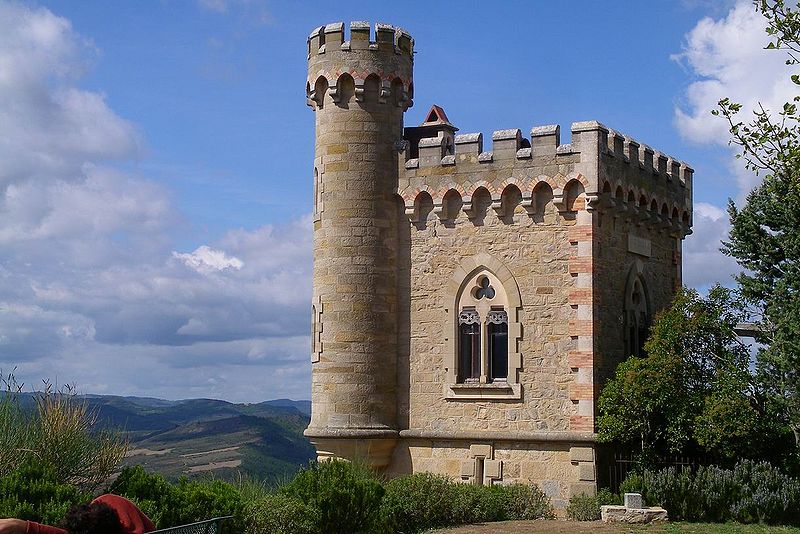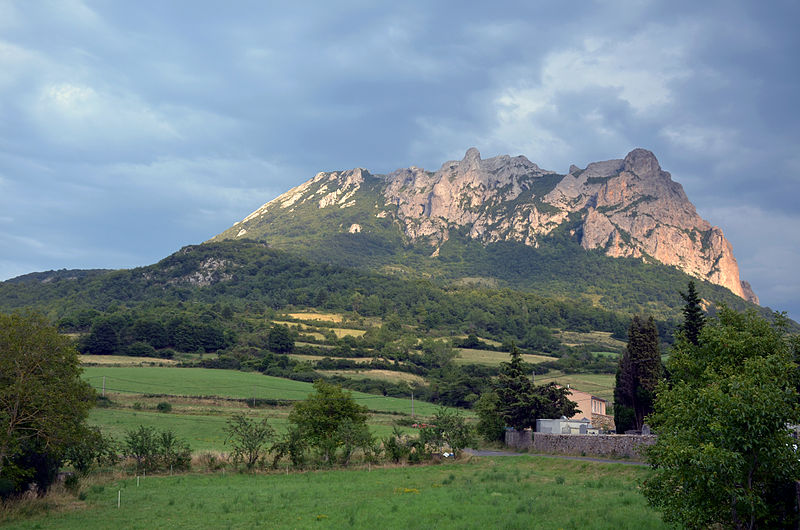THE MYSTERIOUS ARIEGE
The mysterious Ariège: Rennes le Château – Pic de Bugarach
Two emblematic sites in the Aude: Rennes le château and Bugarach
If you’re a fan of legends, then don’t hesitate to head to Cathar country to visit two places famous for their mysteries, in addition to the Château de Lastours, just 60 kilometers from your Ariège campsite.

Rennes le château
The village, built on a rocky outcrop, is made up of very old, tightly-packed houses. It overlooks two valleys, the Aude and the Sals, in the Razès region, a hilly landscape punctuated in places by “puechs” (rocky mountains).
Thanks to this strategic location, the site has developed into a major town at the crossroads of the two valleys. From the belvedere on the terrace of the Domaine de l’Abbé Saunier, you can enjoy an exceptional panorama which, on a clear day, offers a magnificent view of the Pyrenees.
The history of Rennes le Château, beyond the mysteries surrounding its famous parish priest, is rich and chaotic, just like the towns linked to Catharism.
The first Count of Razès, Guillaume de Gellone, took part in the battle of Ronceveaux alongside Roland, both companions of Charlemagne.
From 1170 onwards, Rennes le château went through a troubled period, with part of the town and its defenses destroyed by the King of Aragon, who claimed the county of Razès. Miraculously, Simon de Montfort, the armed wing of the kingdom of France against the followers of Catharism, spared the village during the Albigensian Crusade. However, looters led by Henry II of Castile destroyed the ancient town and fortifications, leaving nothing but ruins. The town never regained its prestige, and Rennes le Chateau became a modest village, which did not prevent it from losing its church during the Wars of Religion.
Today, Rennes le Château has been restored to its former glory, and every year thousands of tourists flock to visit Abbé Saunière’s estate.
Thanks to Bérenger Saunière, the parish priest, the town’s physiognomy and its attraction for the hypothetical treasure it might contain were about to be turned upside down.
Indeed, before the arrival of this parish priest, the church was in a state of disrepair, with cracks in the structure and a roof in need of repair.
From 1885 onwards, the new abbot embarked on a major refurbishment of the church and never stopped, modifying and developing the village with his own funds. This is the origin of the various legends about the treasure the parish priest is said to have found.
There are many hypotheses, all without any proven historical basis. Those most often put forward are the treasure of the Volco-Tectosages from the looting of the sanctuary of Apollo at Delphi; the treasure of the Visigoths, who brought back the treasure from Jerusalem after the sack of Rome; the treasure of the Templars, sheltered at the time of the trial against the rich and powerful Order of the Temple, which owned temples in the region… and many others.
On the other hand, what has been documented is the embezzlement of funds and trafficking in masses that Abbé Saunière practiced, and for which he was condemned by the bishopric following a complaint from local residents about damage and looting in the cemetery.
Places to visit:
- The Renaissance Villa Bethany, now a museum.
- The neo-Gothic Magdala Tower, with its terrace, is linked to a spectacular glass structure.
A beautiful park with a garden containing many exotic plants.
The rumors surrounding the mystery of Rennes le Château have been amplified by books, TV shows and now websites, bringing over 30,000 visitors to the village every year, especially as it’s so close to Bugarach, another emblematic site of esoteric hypotheses.


Bugarach, the peak of many legends
The highest point of the Corbières massif, it overlooks from an altitude of 1,230 metres and offers unrivalled panoramic views of the Pic du Canigou, the Roussillon plain and the Mediterranean, the Ariège Pyrenees and the Haute Vallée de l’Aude as far as the Montagne Noire above Carcassonne. It is also a geological curiosity, as its folded formation means that the upper layers are older than the lower ones. That’s why this peak is also called “the inverted mountain”. And the fact is that the Bugarach peak is reputed to have special telluric properties.
It was also on the pech de Bugarach that astronomers and mathematicians Jean-Baptiste Delambre and Pierre Méchain laid one of the founding milestones of the universal metric system. Taking advantage of the latest advances in mathematics and geometry, notably the triangulation method, the two men climbed the Pic de Bugarach to measure one end of the earth’s arc (from Dunkirk to Barcelona, i.e. a quarter of a meridian). This work, which Arago continued, led to the definition of the “standard meter”, i.e. the 10 millionth part of a quarter of the length of a terrestrial meridian.
At the heart of a region where esotericism thrives, the Bugarach peak is the subject of numerous myths and rumors. These stories oscillate between “end of the world”, “vortex”, “galactic gateway”, “UFO garage”, “magnetic inversion”, “energy center”, “secret base”, “Agartha”, “sanctuary of the Ark of the Covenant” or hiding place for all the world’s treasures (Visigoths, Templars etc.).
The peak has become famous in spite of itself, especially since it was rumoured to be one of the safe havens for the end of the world in December 2012…
The place has always inspired legends, such as the one born locally, which states that the Aude valley used to be an immense fertile plain, but that it suffered from the vagaries of CERS, the son of Aeolus, whose evil wind prevented good harvests, despite the protection of the fairy Nore, the elves Bug and Arach… These implored Jupiter to help them calm Cers’ outrages. So the God of Olympus erected a protective promontory that took the name of Bugarach, allowing the Roussillon plain and Corbières plateau to prosper.
This mountain and its valleys attract hikers and casual walkers to enjoy their beauty and environmental riches. For others, those in search of an inner experience, the initiatory quest passes through this resource place that allows them to commune with the earth’s telluric energy.
Whatever your motivation, Rennes le château and the Bugarach peak promise a great outing during your stay at your campsite, book your accommodation in Ariège.














